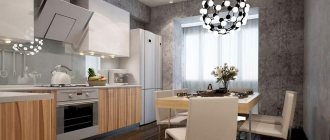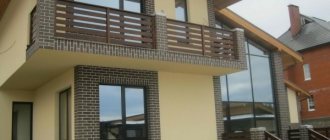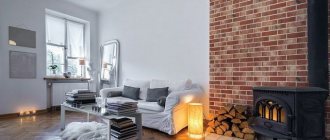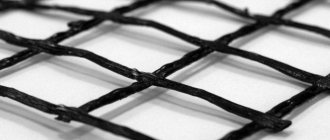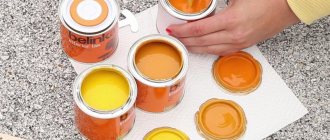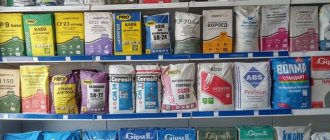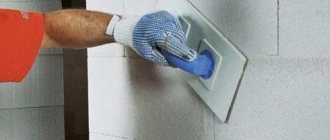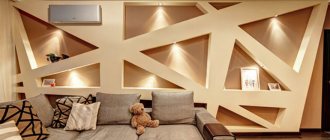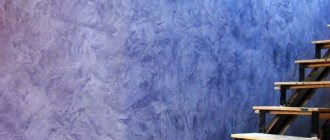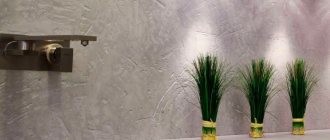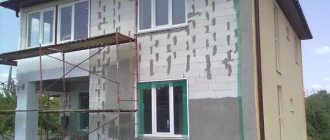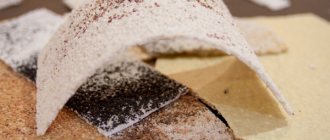Which plaster is suitable for interior work?
Manufacturers offer a wide range of plaster mixtures. Some are used inside, others - outside rooms and premises. After assessing future finishes, experts determine whether gypsum or lime plaster is better suited. But this does not mean their versatility; the choice must be made based on their purpose. They differ in price, properties, and advantages. A mixture that meets the quality has several properties:
- Plastic.
- Water repellency.
- Vapor tightness.
- Resistance to mechanical and weather influences.
There is also a leveling type of plaster mixture for rough finishing, which eliminates cracks, levels the surface, and covers concrete walls, brickwork, wood, gas silicate blocks, expanded clay concrete, and foam blocks.
Therefore, the answer to the question of which plaster is better is this: each is designed to perform its function in repairs.
Note! A finisher's job well done depends on his or her adherence to the process.
Which one to choose, gypsum or cement?
These mixtures are used for finishing renovations in houses and apartments. Cement plaster was obtained by combining the main ingredient with sand and lime; now there are many types of such a ready-made mixture. It is suitable for finishing:
- Facades.
- Cellars.
- Vann.
- Stan.
The surface treated with a cement mixture is durable, which is a positive aspect in finishing both inside and outside.
Gypsum plaster is a dry mass containing plasticizers. To obtain a paste-like consistency, it is diluted with water.
Gypsum plaster:
- easily fits on aerated concrete and brick walls;
- it is used to prepare surfaces for painting and wallpapering;
- It has thermal insulation, sound insulation, fire hazard properties, absorbs moisture, which creates a favorable microclimate in the apartment.
However, it is completely unsuitable for exterior finishing of houses and buildings with high humidity; cement is better suited for such options.
Combination of gypsum and cement
Is it possible to apply gypsum plaster or putty over cement plaster? Yes, this is common practice. When finishing, walls are often painted with a cement-based composition, and a smooth finishing layer of Rotband is placed on top.
Important conditions : you need to wait until the base dries, then be sure to apply a primer between different layers.
But applying cement plaster over a plaster wall is a bad idea .
The plaster simply will not withstand its weight, and the entire finish will crumble. It is worth noting that there are cement-gypsum compositions on sale that combine the advantages of both types, for example, Prospectors MIXTER / MIXTER.
According to the manufacturer, this gypsum-cement plaster is intended for interior spaces with normal and high humidity. This is a moisture-resistant, vapor-permeable material, plastic and easy to apply. The technical characteristics with this mixing turned out to be average between gypsum and cement plaster:
- Consumption for a layer of 10 mm - 10-11 kg/m2
- Water consumption - 0.36-0.42 l/kg
- Setting time - 40 min
- Adhesion to the base - 0.5 MPa
- Layer thickness - up to 60 mm! without using plaster mesh
- Price - 320 rubles per 30 kg bag.
In addition to the main components, this mixture includes a light filler and high-quality modifying additives.
Is it possible to mix cement and gypsum plaster yourself to get a plastic, durable and moisture-resistant solution? No, it won't work that way. Gypsum and cement have different drying times, and if they are mixed by eye and without adding modifiers, the plaster layer on the wall will become covered with cracks. It is better not to experiment with such works so as not to waste time and money.
Pros and cons of cement mortar
Cement mortar is used in construction. Its advantages:
- affordable price, high adhesion strength;
- wide choose;
- moisture resistance;
- retains plasticity for a long time.
Minuses:
- Cracks appear after drying.
- Heaviness of the solution.
- The complexity of the plastering process.
- Poor application on concrete and wood surfaces.
- Long hardening time.
There is still no other alternative to cement mortar.
Pros and cons of gypsum plaster
Rarely does the design of apartments, country houses, restaurants, hotels, exhibition halls and offices take place without this material.
Advantages:
- ease of installation;
- imitation of stone, brick;
- consumer availability;
- a light weight;
- naturalness of the material;
- softness, plasticity;
- heat.
The disadvantages include:
- High water absorption, poor resistance to frost.
- Difficulty in cleaning.
- Gypsum cladding is more suitable for interior work. You should not take risks and cover it with protective agents; it has low resistance to climatic changes.
Gypsum cladding is made in different textures and formats, but, despite some nuances of the material, it is in demand among buyers.
Additional Information! Dry plaster includes plasterboard, produced in sheets. It is used to cover ceilings and walls, replace plastering, install partitions and multi-level structures. The only drawback is the limited strength of the material.
Rotband properties
Rotband is based on gypsum powder. Gypsum is a natural mineral. Its hardness is 3 on the Mohs scale with a maximum of 10. This makes it easy to crush stone.
In powder, gypsum easily absorbs moisture, that is, it is hygroscopic. Most of the rocks are of sedimentary origin. Sedimentary refers to the gradual subsidence and compaction of sediments at the bottom of reservoirs.
Among the sediments there are many remains of living creatures, for example, shells and bones. Their main component is calcium. It also dominates the gypsum formula. Its chemical notation is CaSO4 * 2H2O. Accordingly, gypsum is aqueous calcium sulfate.
Pure plaster is white. This is how a rotband turns out. The plaster may be slightly pinkish or gray. This is not considered a deviation from the standard. There are natural impurities in gypsum.
If the mineral mass is purified from mechanical types of sand and clay, then it is impossible to rid the stone of those built into the chemical formula. Considering that the proportion of foreign elements is negligible and does not affect the quality parameters of the plaster with the exception of its color, impurities are left behind.
The color of the mixture is not indicated on the packaging of Knauf plaster. The shade can be determined, if this is important, by the place of production. The German company has factories in Russia in Krasnogorsk, Krasnodar Territory, Astrakhan and Chelyabinsk regions.
The latter produces pinkish gypsum. Gray is a Krasnogorsk breed. The mineral from the Astrakhan region and Krasnodar region is distinguished by its snow-white color. It is interesting that white and gray mixtures can flow off when applied, that is, they are overly plastic.
This gives horizontal waves on the walls. The phenomenon is explained by the granularity of the gypsum. At the Krasnogorsk and Chelyabinsk deposits, the rock structure contains granules of 0.5 millimeters. In pink deposits there are grains from 1 millimeter.
Therefore, gypsum plaster “Knauf-Rotband” from the Krasnodar Territory and the Astrakhan Region is easier to apply, fixes better and goes on smoother. However, the coarse grain of the coating on the walls is a plus if it is a finishing coating.
If you need a perfectly smooth surface, for example, under wallpaper, it is better to tinker with the application of a white or gray mixture. Adding an additional portion of water to gypsum powder turns it into a plaster slurry.
It is plastic and sticky. The latter property provides the material with good adhesion, that is, the ability to penetrate into the surfaces being treated. In order to fill every crack in them, rotband gypsum plaster contains polymer additives. These include latexes and a number of resins.
The adhesion of the rotband allows it to firmly adhere to plasterboard, concrete, wood and brick bases. On them, Knauf plaster does not shrink or crack.
Rotband is a frost-resistant plaster, surviving 75 cycles and serving well on ceilings, corridors, and entrances. The only problem is the hygroscopicity of the plaster. Gypsum perfectly absorbs moisture not only when mixing the powder, but also during operation.
On the one hand, this allows you to control the microclimate in the room. The coating of walls and ceilings absorbs small and temporary excess vapors, releasing them back when the air dries out. However, if the humidity is high and constant, the plaster swells, loses its aesthetics, and is affected by fungi.
The hygroscopicity of rotband affects its shelf life. It is 6 months from the date of packaging. During this process, atmospheric air enters the bag with plaster, and with it moisture.
Even an unopened rotband begins to crack on the walls when used after six months. It’s not always the finishers’ fault; sometimes you need to check the packaging date of the plaster. By the way, you need to store it packed and in a dry place.
It remains to mention the thermal conductivity of the hero of the article. Finishing material transmits both cold and heat equally poorly. Thermal conductivity is 0.25 watts per meter. In proportion to the indicator of mineral wool - a classic insulation.
Considering that the maximum thickness of rotband application is 5 centimeters, plaster can be a help in insulating the room. However, with a minimum layer thickness of 5 millimeters, you don’t have to expect much from the coating.
Comparison of plasters, characteristics
Plaster mixtures are universal materials for finishing almost any surface. When using them:
- vertical and horizontal seams are filled;
- surfaces are leveled, cracks and unevenness are eliminated;
- additional fire protection is created;
- heat and sound insulation increases.
To understand how gypsum plaster differs from cement plaster or from other types of mortars, you need to read their description:
| Types of mixtures for interior finishing | Properties | Characteristic | Drying time |
| Cement | It is affordable and widely used in construction. | Suitable for rooms with high humidity, bathrooms. | Requires a long drying time of up to 7 days. Acceleration of this process threatens cracking of the layers. |
| Plaster | It is a good heat insulator. Not suitable for wet areas. | Excellent leveling of ceiling surfaces. | Quick drying in 3-4 hours |
| Limestone | Has bactericidal properties. Low strength. | It contains cement, but despite this it is suitable for wooden surfaces. | Dries quickly up to 10 hours. |
| For external use | |||
| Cement for facades | It is cheap. It is vapor permeable. | The outer walls of the building are finished with it, after finishing they breathe and do not become damp | Depending on weather conditions and the layer being applied, it will take several days to dry the walls. |
| Silicone | Plastic and expensive material. | Fits well on the surface. The appearance does not deteriorate even when the walls shrink. | Fast drying. |
| Silicate | Its basis is liquid glass. It has insulating properties and moisture permeability. | Fast adhesion, perfect surface coverage. | Fast hardening. |
| Acrylic | Moisture resistant, low cost, strength, long service life. | Exterior wall decoration for decoration. | From 1 hour to 3 |
The price difference between them is almost unnoticeable. As can be seen from the characteristics of the mixtures, it is better to use gypsum or lime plaster for interior decoration. When choosing these mixtures when purchasing, you need to pay attention to the information on its use on the packaging.
Methods of application and leveling
Plaster is applied:
- manually - the mass is smeared by hand with virtually no tools;
- instrumental - they create drawings with devices;
- in a mechanized way - large areas are processed, helps to combine several stages of work, and evenly apply the plaster layer.
Leveling the surface in apartments is carried out with a plumb line or building level. Working tools – spatula, rules, graters. In industrial buildings, alignment is carried out with beacons.
Curing and drying times
Compliance with technology in finishing work does not delay the construction process. Rapid curing and drying of surfaces is affected by:
- Weather.
- Microclimate of the room.
- Overlay layer.
The finishing thickness is small, up to 10 mm. A layer of 20-40 mm dries up to 14 days, layers of 50-80 mm dry up to 20 days.
Stages of work
Knauf Rotband plaster is easy to use. However, it should only be applied to a prepared surface. In addition, it is important to prepare the solution correctly and apply the mixture correctly.
To work you will need the following tools:
- perforator, hammer, and other impact tools for removing bumps;
- construction mixer or drill with a kneading attachment;
- mixing container;
- profiles, beacons, rule;
- spatula and falcon for applying plaster;
- steel spatula for leveling the surface;
- grater, grater.
Materials other than plaster will require primer and cement to fill dents that are too large.
Preparation of the base and mixture
Fine gypsum plaster. This means that walls and ceilings need to be prepared for it.
- The surface is cleaned of old finishes, dirt and dust are removed. Grease and oil stains are wiped off with gasoline or solvents.
- Level the wall or ceiling. Lumps and nodules are knocked down with a hammer or perforator. Too large potholes and deep cracks are sealed with cement mortar.
- If the surface is smooth, a notch is made to improve adhesion. It is recommended to prime it.
- The plaster is applied along the beacons. To do this, slides of plaster are attached to the wall at a distance of 40 cm. Beacons are pressed into the moldings. Later the mixture will be applied according to the level. Corner profiles are set to the same level as the beacons. Modeling for them is applied inside the racks.
- Mix the solution in the recommended proportions: pour 18 liters of water into a bucket and add plaster. First, pour out 6 spatulas of the dry mixture, stir until smooth, then pour out the entire bag. Stir with a mixer; doing it by hand is more difficult.
Valera
The voice of the construction guru
Ask a Question
The plaster solution does not immediately reach the desired condition. After kneading, you need to wait 5-6 minutes, during which the composition will gain thickness. If it remains liquid after standing, you need to add gypsum.
Application technology
Leveling the plaster using the rule
The solution retains its plasticity for 20–25 minutes. During this time it must be used. Therefore, Rotband recommends cooking in small portions.
- Plaster is applied to the wall with a spatula, and on the ceiling with a falcon. Then, using the rule, the surface is leveled according to the beacons. The rule should be 40 cm longer than the distance between the beacons - 20 cm on each side.
- If 1 layer is not enough, add a second one and also level it using the same rule. The second layer is applied after 1 day.
- If the surface is satisfactory, it is leveled 50 minutes after applying the plaster. To do this, take a lath or large spatula and, performing movements in one direction, level the surface. Excess composition is removed.
- If a wall or ceiling is being prepared for painting or wallpaper, they are additionally rubbed down. To do this, moisten the grater generously and smooth the surface in a circular motion.
At this stage, you can give the wall an unusual texture. For example, after leveling, the rule is to run a rubber roller with a pattern along the wall. Using a regular spatula, you can create an imitation of a rocky surface.
Drying time
Tools should be washed immediately after use.
Rotband plaster sets in 45–60 minutes. After this you can rub it out. But if you need to apply the next layer, you will have to wait a day. Otherwise, the fresh layer will not hold.
final strength after 7 days . It is recommended to postpone painting or pasting for this period.
On instruments, plaster sets and dries quickly. Therefore, after work, spatulas, trowels, falcons, and graters are immediately cleaned.
